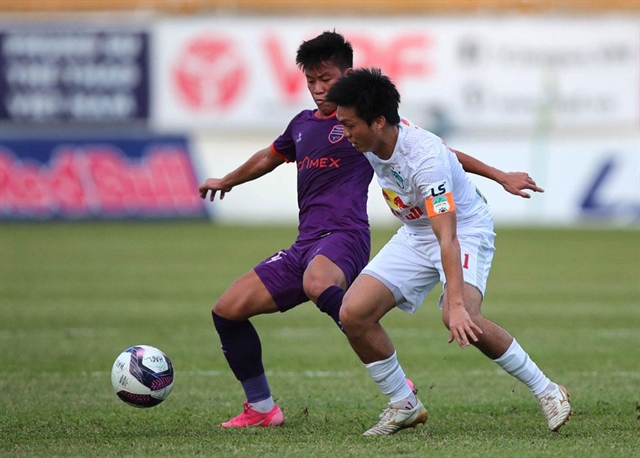
The VPF is aiming for a February return to domestic competition. Photo thanhnien.vn
Peter Cowan
You could be forgiven for thinking otherwise, but club football is actually played in Việt Nam.
Since May and the suspension of the domestic season, anything to do with the beautiful game in this country has revolved around the national team, but at long last there are noises about preparing for the 2022 V.League season.
Late last week, the Việt Nam Professional Football Company (VPF) held an online meeting with all 27 clubs in the top two tiers to discuss the schedule for next year’s season, according to e-newspaper Zing.
It seems no matter what format is chosen, play will kick off after Tết (Lunar New Year) in February, a full nine months after a ball was last kicked in anger between club teams.
Waiting to play until after Tết I can understand for weather reasons and to work around the national team’s World Cup and AFF Cup schedule, but I have less time for the proposal to reuse the “split” approach to fixtures.
At the meeting, the VPF reportedly mooted playing the league in the usual home and away format, meaning 26 games for each team in the top-flight, or by splitting the league into two groups after each team has played each other once, leading to a maximum of 20 matches per team.
The thinking behind the truncated season is likely to allow time to replay fixtures postponed due to COVID-19 outbreaks and while the league is right to be thinking ahead, I would hate to think this option is a serious possibility.
With Việt Nam moving forward to live with the virus in the “new normal” instead of aiming for a zero-COVID policy, it would be a real shame to make absurdly short and competitively unbalanced football seasons part of that new normal.
For one thing the shorter season just feels wrong if every team isn’t playing each other home and away, for another the lack of competitive action is holding back the development of Vietnamese players and the league as a whole.
But more than anything else, to this armchair epidemiologist, it’s a relic of a different stage of the pandemic.
With infection and death figures plunging significantly in recent weeks and almost 62 million vaccine doses administered, the state of play has changed dramatically from just a few months ago.
Semi-regular outbreaks of this virus will probably be a part of all of our lives for the foreseeable future and as more of the population becomes vaccinated it’s a reality that’s becoming more acceptable, and football has to get on board.
Neither the VPF nor the culture and sports ministry have the power to unilaterally decide if football can be played during an outbreak, but what they can do is make a strong case to those making the decisions that football can be played safely.
No one wants football to be played in empty stadiums but if the alternative is suspension of play, the powers that be need to show it can be done safely.
Just look at what the Viet Nam Basketball Association (VBA) did with their mini-season in Nha Trang in the summer.
While the “bubble” model is not ideal for football and the costs of keeping teams in hotels for weeks on end would be prohibitive, the VPF (and health authorities) should be able to learn a thing or two from a league that played a lot of fixtures at the height of the fourth wave in a safe manner.
Inter-provincial travel will likely be a sticking point going forward, and in the absence of some sort of national directive on travel for professional sport, this is where clubs will have to make the case to their local authorities that it can be done safely.
It feels like life is going back to something close to normal in many senses, let’s not bring the stop-start football of the last two years with us into the new world. VNS
OVietnam